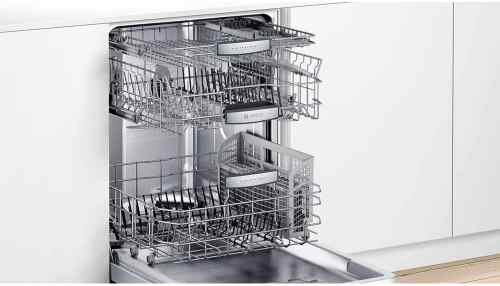Dishwashers have become an essential appliance in every modern kitchen. They make our lives easier by saving time and effort, and they provide a more efficient way to clean dishes. Hisense is a renowned brand that produces high-quality home appliances, including dishwashers. Their dishwashers are reliable and efficient, but sometimes they can experience error codes that can be confusing for users. In this article, we will discuss the most common Hisense dishwasher error codes, their meanings, and possible solutions to help you troubleshoot and fix the issue.
Common Hisense Dishwasher Error Codes:
- E1 Error Code:
The E1 error code on a Hisense dishwasher indicates a water inlet error. This means that the dishwasher is not receiving enough water, or the water supply is interrupted. The possible reasons for this error code could be a clogged water inlet valve, a malfunctioning water inlet valve, or a faulty water level sensor. To fix this issue, you can try cleaning the water inlet valve and checking the water supply. If this does not work, you may need to replace the water inlet valve or the water level sensor.
- E2 Error Code:
The E2 error code on a Hisense dishwasher indicates a drain error. This means that the dishwasher is not draining the water properly. The possible reasons for this error code could be a clogged drain hose, a blocked sink or garbage disposal, or a malfunctioning drain pump. To fix this issue, you can try cleaning the drain hose and checking the sink or garbage disposal for any blockages. If this does not work, you may need to replace the drain pump.
- E3 Error Code:
The E3 error code on a Hisense dishwasher indicates a heating error. This means that the dishwasher is not heating the water properly. The possible reasons for this error code could be a faulty heating element, a malfunctioning thermostat, or a broken circulation pump. To fix this issue, you can try checking the heating element and thermostat for any damage or faults. If they are fine, you may need to replace the circulation pump.
- E4 Error Code:
The E4 error code on a Hisense dishwasher indicates an overflow error. This means that the dishwasher has detected an overflow of water. The possible reasons for this error code could be a clogged drain hose, a faulty water inlet valve, or a malfunctioning water level sensor. To fix this issue, you can try cleaning the drain hose and checking the water inlet valve and water level sensor. If this does not work, you may need to replace the faulty part.
- E5 Error Code:
The E5 error code on a Hisense dishwasher indicates a motor error. This means that the dishwasher’s motor is not working properly. The possible reasons for this error code could be a broken motor, a malfunctioning control board, or a faulty wiring harness. To fix this issue, you may need to replace the motor, control board, or wiring harness.
Frequently Asked Questions (FAQs):
Q: How do I reset my Hisense dishwasher?
A: To reset your Hisense dishwasher, you can try turning off the power supply for a few minutes and then turning it back on. Alternatively, you can try pressing and holding the start/pause button for a few seconds until the display screen turns off.
Q: How do I clean my Hisense dishwasher?
A: To clean your Hisense dishwasher, you can try using a dishwasher cleaner or a mixture of vinegar and water. You can also remove the dishwasher racks and wash them with warm, soapy water. Additionally, you can try cleaning the dishwasher’s filter and spray arm with a soft-bristled brush.
Q: Why is my Hisense dishwasher not drying dishes?
A: If your Hisense dishwasher is not drying dishes, it could be due to a few reasons. Firstly, make sure that you are using the appropriate detergent for your dishwasher. Certain types of detergent can cause excess suds that can interfere with the drying process. Additionally, you can try adjusting the dishwasher’s drying settings or using a rinse aid to improve the drying performance. If the issue persists, it could be due to a faulty heating element or thermostat, and you may need to contact a professional for assistance.
Q: Can I use bleach in my Hisense dishwasher?
A: No, it is not recommended to use bleach in your Hisense dishwasher as it can damage the dishwasher’s components and cause corrosion. Instead, use a dishwasher cleaner or a mixture of vinegar and water to clean your dishwasher.
Q: How do I troubleshoot a Hisense dishwasher that won’t start?
A: If your Hisense dishwasher won’t start, check if the dishwasher is properly connected to the power supply and if the circuit breaker has tripped. Additionally, make sure that the dishwasher door is fully closed and that the control panel is not locked. If these are not the issues, it could be due to a faulty control board or door latch, and you may need to contact a professional for assistance.
Q: How often should I clean my Hisense dishwasher?
A: It is recommended to clean your Hisense dishwasher every three to six months to ensure optimal performance and prevent any potential issues. You can use a dishwasher cleaner or a mixture of vinegar and water to clean the dishwasher’s interior, filter, and spray arm.
Conclusion:
In conclusion, Hisense dishwashers are reliable and efficient appliances that can make your life easier. However, like any appliance, they can experience error codes that can be frustrating for users. By understanding the most common Hisense dishwasher error codes and their solutions, you can troubleshoot and fix any issues that may arise. Additionally, following proper cleaning and maintenance practices can ensure that your dishwasher continues to function optimally and last for years to come.

